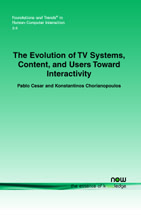The Evolution of TV Systems, Content, and Users Toward Interactivity
By Pablo Cesar, CWI, , P.S.Cesar@cwi.nl | Konstantinos Chorianopoulos, Department of Informatics, Ionian University, Corfu, Greece, choko@ionio.gr
Abstract
Interactive TV research spans across a rather diverse body of scientific subfields. Research articles have appeared in several venues, such as multimedia, HCI, CSCW, UIST, user modeling, media and communication sciences. In this study, we explore the state-of-the-art and consider two basic issues: What is interactive TV research? Can it help us reinvent the practices of authoring, delivering, and watching TV? For this purpose, we have reviewed the research literature, as well as the industrial developments and identified three concepts that provide a high-level taxonomy of interactive TV research: (1) content editing, (2) content sharing, and (3) content control. We propose this simple taxonomy (edit–share–control) as an evolutionary step over the established hierarchical produce–deliver–consume paradigm. Moreover, we demonstrate how each disciplinary effort has contributed to and why the full potential of interactive TV has not yet been fulfilled. Finally, we describe how interdisciplinary approaches could provide solutions to some notable contemporary research issues.
'Interactive Television is an oxymoron. On the other hand, television provides the most common ground in our culture for ordinary conversation, which is arguably the most enjoyable interaction a person has. We should try to leverage the power of television while creating some channel back from the audience to provide content, control or just a little conversation.'
The Evolution of TV Systems, Content, and Users Towards Interactivity
The Evolution of TV Systems, Content, and Users towards Interactivity provides an overview of the evolution of TV systems, TV content, and TV users towards interactivity, with a special focus on sociability aspects. Three basic concepts are introduced, namely, content editing, content sharing, and content control. Content editing corresponds to the activity of developing or organizing multimedia material, traditionally the domain of professionals but also including user-generated content. Content sharing refers to all kinds of social activities that might occur around television watching, such as chatting about television content and sharing content. Finally, content control corresponds to the activity of deciding what to watch and how to watch it. A simple taxonomy (edit-share-control) is proposed as an evolutionary step over the established hierarchical produce-deliver-consume paradigm. The Evolution of TV Systems, Content, and Users towards Interactivity looks at how research in the area has spanned a rather diverse set of scientific subfields, such as multimedia, HCI, CSCW, UIST, user modeling, media and communication sciences. It demonstrates how each disciplinary effort has contributed and why the full potential of interactive TV has not yet been fulfilled. Finally, it describes how interdisciplinary approaches could provide solutions to some notable contemporary research issues. The Evolution of TV Systems, Content, and Users towards Interactivity is aimed at students and researchers, practitioners and developers. It assumes a basic understanding of past and current practices on the design of computer applications, networks and media content.
